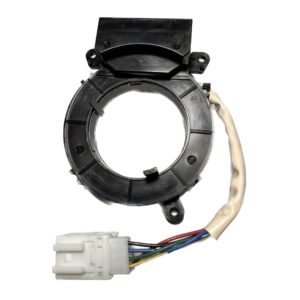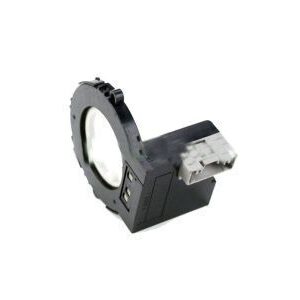**Navigating Precision: The Evolution and Importance of Steering Angle Sensors**
In the intricate mechanics of an automobile, where control and safety intertwine, one often-overlooked component plays a pivotal role—the steering angle sensor. While the steering wheel commands attention as the driver’s interface with the vehicle, the steering angle sensor quietly ensures accurate steering control and stability. Join us as we explore the evolution, functionality, and significance of steering angle sensors in modern automotive technology.
**Understanding the Essence: What is a Steering Angle Sensor?**
A steering angle sensor, often abbreviated as SAS, is a critical component of a vehicle’s electronic stability control system. Located within the steering column or steering gear assembly, the sensor detects the position and angle of the steering wheel, providing crucial data to the vehicle’s electronic control unit (ECU) or stability control system. This information allows the system to monitor the vehicle’s direction and stability and make adjustments to braking and traction control systems as needed.
**The Evolution of Steering Control**
In the early days of automotive engineering, steering control relied solely on mechanical linkages between the steering wheel and the wheels. However, as vehicles became more advanced and electronic systems proliferated, the need for precise steering control and stability management became apparent. Steering angle sensors emerged as a key technology in this evolution, enabling vehicles to respond dynamically to changing driving conditions and maintain optimal stability and control.
**The Significance of Stability and Control**
In the dynamic environment of modern driving, where road conditions can change in an instant, maintaining stability and control is crucial for safe operation. Steering angle sensors play a pivotal role in this regard, providing real-time data on steering inputs and vehicle dynamics to the vehicle’s stability control system. By monitoring the vehicle’s direction and stability, the system can intervene as needed to prevent skidding, loss of traction, and other potentially dangerous situations.
**The Silent Observer: How Does a Steering Angle Sensor Work?**
Despite its unassuming appearance, the steering angle sensor employs sophisticated technology to fulfill its role effectively. Most steering angle sensors utilize either potentiometer or Hall effect sensor technology to detect the position and angle of the steering wheel.
As the steering wheel is turned, the sensor generates electrical signals that vary with the angle of rotation. These signals are then processed by the vehicle’s ECU or stability control system, which uses the data to calculate the vehicle’s steering angle and make adjustments to stability control systems as needed.
**The Unseen Benefits: Advantages of Steering Angle Sensors**
While steering angle sensors may operate quietly behind the scenes, their impact on vehicle safety and stability is undeniable. Here are some key advantages of steering angle sensors:
1. **Enhanced Safety:** Steering angle sensors help improve vehicle stability and control, reducing the risk of skidding, loss of traction, and other potentially dangerous situations.
2. **Improved Handling:** By providing real-time data on steering inputs and vehicle dynamics, steering angle sensors enable more precise and responsive handling, especially in challenging driving conditions.
3. **Optimized Traction Control:** Steering angle sensors allow the vehicle’s stability control system to intervene as needed to prevent wheel slip and optimize traction, improving overall vehicle performance and safety.
4. **Advanced Driver Assistance:** Steering angle sensors serve as a foundational technology for advanced driver assistance systems (ADAS), enabling features such as lane-keeping assist, adaptive cruise control, and autonomous driving capabilities.
**Looking Ahead: The Future of Steering Control Technology**
As automotive technology continues to advance, so too will the field of steering control technology. Innovations in sensor design, integration with vehicle systems, and connectivity to advanced driver assistance systems (ADAS) may lead to even more responsive and intelligent steering control solutions in the future.
Furthermore, as vehicles transition towards electrification and autonomous driving, steering angle sensors will play a crucial role in optimizing vehicle dynamics, improving safety, and enhancing the overall driving experience.
**In Conclusion: The Precision Navigator of Vehicle Control**
In the dynamic landscape of automotive engineering, where precision and safety are paramount, steering angle sensors emerge as silent but indispensable navigators of vehicle control. Their unassuming presence belies their critical importance in ensuring stable, responsive, and safe operation of modern vehicles. So, the next time you navigate a winding road or navigate through traffic, remember to thank the unsung hero working diligently behind the scenes—the steering angle sensor.
Only 4 left in stock (can be backordered)
$88,855.34
**Navigating Precision: The Evolution and Importance of Steering Angle Sensors**
In the intricate mechanics of an automobile, where control and safety intertwine, one often-overlooked component plays a pivotal role—the steering angle sensor. While the steering wheel commands attention as the driver’s interface with the vehicle, the steering angle sensor quietly ensures accurate steering control and stability. Join us as we explore the evolution, functionality, and significance of steering angle sensors in modern automotive technology.
**Understanding the Essence: What is a Steering Angle Sensor?**
A steering angle sensor, often abbreviated as SAS, is a critical component of a vehicle’s electronic stability control system. Located within the steering column or steering gear assembly, the sensor detects the position and angle of the steering wheel, providing crucial data to the vehicle’s electronic control unit (ECU) or stability control system. This information allows the system to monitor the vehicle’s direction and stability and make adjustments to braking and traction control systems as needed.
**The Evolution of Steering Control**
In the early days of automotive engineering, steering control relied solely on mechanical linkages between the steering wheel and the wheels. However, as vehicles became more advanced and electronic systems proliferated, the need for precise steering control and stability management became apparent. Steering angle sensors emerged as a key technology in this evolution, enabling vehicles to respond dynamically to changing driving conditions and maintain optimal stability and control.
**The Significance of Stability and Control**
In the dynamic environment of modern driving, where road conditions can change in an instant, maintaining stability and control is crucial for safe operation. Steering angle sensors play a pivotal role in this regard, providing real-time data on steering inputs and vehicle dynamics to the vehicle’s stability control system. By monitoring the vehicle’s direction and stability, the system can intervene as needed to prevent skidding, loss of traction, and other potentially dangerous situations.
**The Silent Observer: How Does a Steering Angle Sensor Work?**
Despite its unassuming appearance, the steering angle sensor employs sophisticated technology to fulfill its role effectively. Most steering angle sensors utilize either potentiometer or Hall effect sensor technology to detect the position and angle of the steering wheel.
As the steering wheel is turned, the sensor generates electrical signals that vary with the angle of rotation. These signals are then processed by the vehicle’s ECU or stability control system, which uses the data to calculate the vehicle’s steering angle and make adjustments to stability control systems as needed.
**The Unseen Benefits: Advantages of Steering Angle Sensors**
While steering angle sensors may operate quietly behind the scenes, their impact on vehicle safety and stability is undeniable. Here are some key advantages of steering angle sensors:
1. **Enhanced Safety:** Steering angle sensors help improve vehicle stability and control, reducing the risk of skidding, loss of traction, and other potentially dangerous situations.
2. **Improved Handling:** By providing real-time data on steering inputs and vehicle dynamics, steering angle sensors enable more precise and responsive handling, especially in challenging driving conditions.
3. **Optimized Traction Control:** Steering angle sensors allow the vehicle’s stability control system to intervene as needed to prevent wheel slip and optimize traction, improving overall vehicle performance and safety.
4. **Advanced Driver Assistance:** Steering angle sensors serve as a foundational technology for advanced driver assistance systems (ADAS), enabling features such as lane-keeping assist, adaptive cruise control, and autonomous driving capabilities.
**Looking Ahead: The Future of Steering Control Technology**
As automotive technology continues to advance, so too will the field of steering control technology. Innovations in sensor design, integration with vehicle systems, and connectivity to advanced driver assistance systems (ADAS) may lead to even more responsive and intelligent steering control solutions in the future.
Furthermore, as vehicles transition towards electrification and autonomous driving, steering angle sensors will play a crucial role in optimizing vehicle dynamics, improving safety, and enhancing the overall driving experience.
**In Conclusion: The Precision Navigator of Vehicle Control**
In the dynamic landscape of automotive engineering, where precision and safety are paramount, steering angle sensors emerge as silent but indispensable navigators of vehicle control. Their unassuming presence belies their critical importance in ensuring stable, responsive, and safe operation of modern vehicles. So, the next time you navigate a winding road or navigate through traffic, remember to thank the unsung hero working diligently behind the scenes—the steering angle sensor.
| Weight | 0.08 kg |
|---|---|
| Warehouse | Inventory at warehouse 2 |



Get E-mail updates about our latest products and special offers.
Sensors and More is Jamaica’s ultimate online auto parts store. Established in 2020, we specialize in genuine electrical parts for Japanese, Read more…
Reviews
There are no reviews yet.